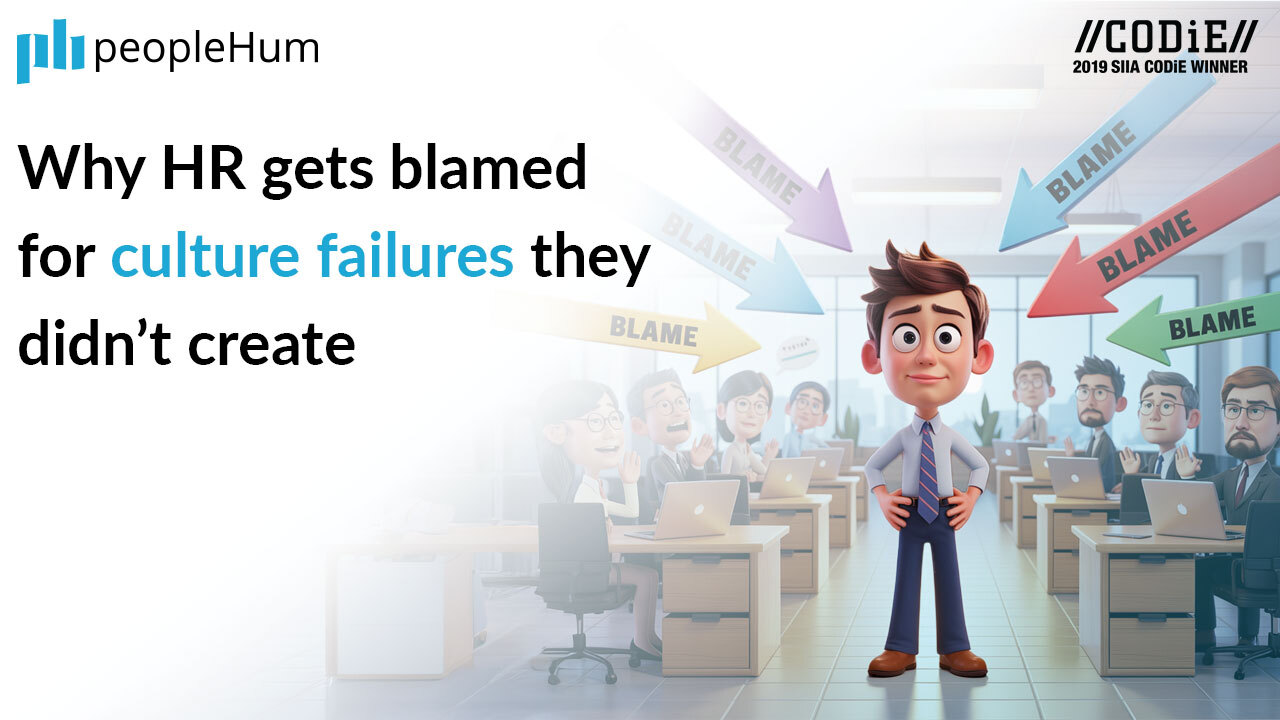When a company’s culture goes south, because of a bad boss, people quitting, or just a lack of energy everyone looks at HR. It’s like they're the only ones who can fix it, even though they didn't cause the problem. Why is HR blamed for culture issues they didn't create? This isn’t just unfair; it's a big-picture problem that has been hurting businesses for a long time.
This happens because HR is the face of “people stuff.” So when the culture tanks, it’s easy for everyone, executives, employees, even that guy in accounting who never smiles, to dump it all on you. But culture isn’t just HR’s job. It’s shaped by every decision, every leader, and every unchecked behavior in the organization.
What does “culture failure” mean?
Cultural failure is when the workplace feels like a soul-sucking void. This can be high turnover, low morale, or a general vibe where nobody trusts anybody. Culture failures show up in different ways: employees ghosting meetings because they’re checked out, managers playing favorites, or diversity initiatives that are just lip service. It’s not one bad day, it's a pattern. And HR is often the first to notice because you’re fielding the complaints, exit interviews, and those anonymous. It is built or broken) by everyone, executives, managers, even that intern who keeps microwaving fish. So why does HR always get the blame?
Leadership’s actions not HR words, define culture
The C-suite owns the company culture. The people in the corner offices or fancy Zoom backgrounds set the tone for everyone else. If a CEO promotes a "hustle harder" mentality while ignoring burnout, that message trickles down to every team. A company's culture is not built by HR policies; it's defined by leadership's actions, priorities, and offhand comments.
- The finger-pointing trap: When culture issues arise, executives rarely look in the mirror. Instead, they shift the blame to HR, asking why you aren't "fixing this." You are left to clean up a mess created by decisions you had no part in making. The toxic manager a CEO refused to address, for example, is not your fault, but when the team quits and morale plummets, you get the blame.
- The powerless policeman: Leaders often expect HR to be the "culture police" while giving you no real authority. You can suggest and advise, but if the C-suite isn't actively demonstrating the values they claim to uphold, your efforts are pointless.
- The accountability void: The next time someone blames HR for a toxic culture, ask them about leadership's role. The silence you get will be all the answer you need.
Managers are the real culture killers
Middle managers are the ones who think “management” means forwarding emails and taking credit for their team’s work. These folks are the boots on the ground, the ones employees interact with daily. A bad manager can turn a decent culture into a dumpster fire faster than you can say “performance review.” They’re the ones enforcing policies, setting the team’s mood, and deciding whether feedback is welcomed or punished.
HR doesn’t manage these managers. It trains them, gives them the handbook, the workshops, or leadership courses. But if they’re out there playing favorites, shutting down ideas, or being a general jerk, that’s not HR’s doing. HR can’t babysit every manager’s every move. Yet, when their team’s engagement scores tank or someone files a complaint, HR is the one being called out. It’s like being blamed for a car crash when you only sold the driver the keys.
The other side of the coin: Employees Aren't Blameless
Employees are not innocent bystanders in shaping company culture. Culture isn't something that's simply "done to them." It's built in every interaction: every ignored meeting invite, every snarky message, and every time someone gossips instead of communicating directly. They are active participants, and they contribute to the very environment they live in.
- The expectations: Employees often expect HR to solve all their problems. A broken coffee machine, a difficult coworker, or a new policy they dislike suddenly, it's HR’s fault. They treat you like a parent who can fix everything, failing to recognize their own part in the dynamic.
- The blind spot: When the culture feels off, employees are quick to point fingers at HR. They don't see their own role in the problem. Instead of looking inward, they place the blame on the most visible target, the person sending the emails, and asking for feedback.
- The unseen efforts: HR is invisible to them, they don't see the behind-the-scenes work, the long hours spent advocating for better benefits, pushing for mental health resources, or trying to convince leadership to change for the better. It's only about the outcome, and if it's not perfect, you become the easy target.
HR’s role Is misunderstood and that’s a problem
HR isn’t the culture creator, it's the facilitator, the guide, the one trying to keep the ship from sinking while everyone else pokes holes in it. Your job is to set up systems, hiring processes, training programs, and feedback channels that support a good culture. But you can’t force people to use them right, you can’t make the VP of Sales stop yelling at their team.
The problem is, nobody gets this. To most people, HR is the catch-all for anything people-related. If culture is not great it must be HR’s fault. Nobody bothers about the million tasks with a budget that wouldn’t cover a decent office pizza party. The expectation is that you’re somehow responsible for every smile or frown in the workplace.
The “Fix it” mentality puts HR in a trap
- The expectation vs. reality: You're tasked with running initiatives and spending the budget, but you can't address the real problems, like bad leadership or disengaged managers. You know that genuine change requires commitment from everyone, especially the people at the top.
- The setup for failure: You can do everything right, implement programs, host workshops, and gather feedback but if the underlying issues aren't addressed by leadership, nothing will change. When the employee survey results don't improve, you're the one who gets blamed.
- The vicious cycle: This creates a continuous cycle of frustration. HR is expected to fix a problem that's out of their control. Companies rely on quick fixes instead of real accountability, and HR is left to take the fall when the surface-level solutions fail.
How HR can push back without getting fired
HR is not powerless, even if it feels that way sometimes. The key is to shift the narrative and get real about what culture takes. Here’s how to push back without burning bridges:
- Call out the real culprits. Next time someone blames HR for a culture issue, gently point out where it’s coming from. Be subtle, but it puts the spotlight where it belongs.
- Educate people. Most people don’t get what HR does. Use every chance you get meetings, town halls, even casual chats to clarify your role. Explain that culture is a team sport, not HR’s solo act. The more you set expectations, the less you’ll be scapegoated.
- Get data on your side. Numbers don’t lie. Use engagement surveys, exit interviews, or even anonymous feedback to show what’s really driving culture issues. If the data points to leadership or manager behavior, let it speak for itself. It’s harder to argue with cold, hard facts.
- Stop overpromising. You’re not a miracle worker. When leadership asks for a quick fix, be honest about what it’ll take. Say, “We can run a workshop, but real change needs commitment from the top.” It’s risky, but it sets boundaries and protects you from being set up to fail.
- Build allies. Find the leaders and managers who get it, the ones who actually care about culture. Partner with them to drive small wins, like better team communication or fairer recognition programs. It’s easier to make change when you’re not fighting alone.
Final thought: Why culture is everyone’s job
Culture is the whole company’s responsibility. Every decision, from the CEO’s priorities to the intern’s attitude, shapes the vibe. HR can set the stage from hiring the right people, creating fair policies, fostering open communication but you can’ play all the parts. If the C-suite’s checked out, managers are toxic, or employees are disengaged, no amount of HR magic will fix it.
HR keeps getting blamed because you’re the easy target. You’re visible, accessible, and often the only ones actually trying to make things better. But it’s time to flip the script. Culture failures happen when everyone drops the ball, not just HR.
Platforms like PeopleHum become an invaluable ally in shifting this mindset. By providing transparent tools for performance management, employee feedback, and goal setting, PeopleHum empowers managers and individual contributors to take ownership of their role in the company's culture. This reframes HR's role from a lone culture-fixer to a strategic partner who provides the infrastructure for everyone else to step up.



































.png)
.jpg)













